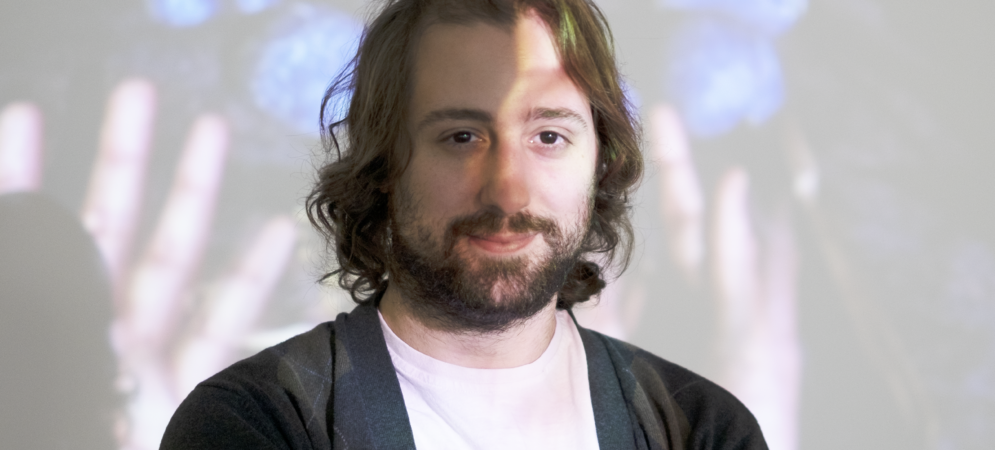Meet Victor Pardinho
Victor is the co-founder and CEO of Sense of Space, a startup building content creation tools for the future of volumetric video and XR technologies. As a designer, researcher and producer, he has worked with several international studios, companies and research groups, with projects presented in Europe, Asia, North and South America. Victor has an MA in New Media Design and Production and has been a researcher in visual and immersive technologies since 2011. His work engages with technology and storytelling, exploring the future of immersive and interactive experiences.
1. How did you get your idea or concept for the business?
It all started during my research years in immersive technologies, and how to properly bring real people and human performances into VR and AR without looking uncanny and weird. After trying out several different options, such as motion-capture or 360 videos, I fell in love with volumetric video, as the only technology that can truly transport how people authentically move and look into virtual worlds.
2. What’s your company’s vision?
Our mission is to make volumetric storytelling possible for everyone, without the need for strong technological knowledge. If you’re a digital creative and you know the basics of video editing, or how to shoot a regular video, then you’re now able to also explore the possibilities of volumetric video, and create your own immersive experiences in a much faster and easier way.
3. What is unique about your business?
Our business and tools are made by creatives for creatives, so we take really good care of great UI and UX, we know deeply the pains of content creation for XR and we praise for a much more intuitive and pleasurable workflow. Avoiding to make content creators and creative people to drown themselves into technical issues, ending up highly frustrated, which is what usually happens with the current tools in the market.
4. What is your biggest achievement so far?
We are a young startup with a small team and we already managed to release a tool for everyone to be able to download and create volumetric projects with. When people try or see our tools in use, they can’t believe we did something like that in such a short period of time, with such a small team, so we’re really proud of it.
5. How do you see your company in 10 years?
Our goal is to give everyone the possibility to create XR content and tell their stories in this amazing new medium. In 10 years from now, we hope to give the whole infrastructure and end-to-end possibilities for every creative in the world, no matter the level of technical knowledge, to make their own content. We can’t wait to see all the amazing stories that people will be able to share using our tools.
6. What are you like as an employer?
As a startup, we really praise for horizontality in our company, everyone is able to give their opinions and that will be taken into account. We like to be highly transparent and share strategic and future visions of the company with everyone in the team. We’ve some employees that came from the corporate world, and they’re usually quite happy that with us, they can really know what’s the vision for the future of the company, and have their opinions taken into account, being part of the company as one strong team.
7. What do you think are the biggest challenges facing the XR industry? How do you deal with them?
I believe the same answer as any XR professional would give: wider distribution!
The biggest challenge is how to get all these possibilities to a broader audience, and for that, we must work together to make it possible, from telecommunication infrastructures to hardware and software. In our case, we really believe in WebAR as a simple and effective way for sharing XR stories, and that’s why with our tool, Sense XR Studio, content creators will soon be able to share their experiences in WebAR with just a single click.
8. How do you handle adversity and doubt?
We are a startup, so that’s our day-to-day challenge. But we love challenges, otherwise, we wouldn’t be doing what we do. We’re creating something new, that has never been done before. We are up for the challenge to make it happen and we welcome everyone that wants to come with us on this journey.
9. If you had one piece of advice to someone just starting out in VR/AR, what would it be?
Experiment! Try out new things, there is a lot of good content nowadays in VR and AR. Amazing projects and experiences, try all that out, get yourself immersed in and listen to what others have to say and what they’ve done. Don’t think that you’ll be making a ground-breaking VR/AR experience if you don’t experience what’s out there, there’s a lot to learn already!
10. What is one habit you wish you could break?
Wanting to do new features all the time 🙂
11. What does creativity mean to you?
Everything. If I’m not doing something creative myself, making tech stuff to enable something creative, exploring a creative work from someone else or discussing it with friends, then I’m probably sleeping.
12. What book has inspired you the most?
I could name a few but since we’re talking about XR it will have to be Neuromancer by William Gibson.
13. What do you do when you’re not at work?
I like to travel when possible, go around places, parks, bars, also play football and basketball. In the case of rain or pandemic, watching things at home or playing games with friends.
14. Who do you see as an inspiration in the industry? (Please name up to 3 people from the XR industry)
John Carmack, Nonny de la Peña and James George from Scatter.
